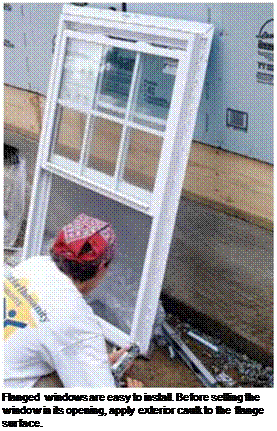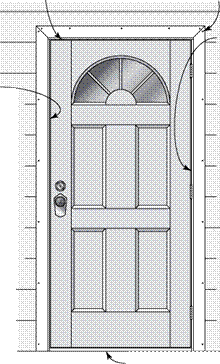STEP 3 SET THE WINDOWS AND DOORS
The setting process anchors the windows and doors in their final positions. Complete installation happens later, when we move inside the house and work on the interior trim. The windows and doors used in affordable housing are mainly vinyl and vinyl clad, though aluminum-clad frames are still installed in some areas. Some codes require that window frames be clad with white vinyl; check with your local building department. Dark-colored vinyl absorbs more solar heat and, as a result, tends to deteriorate faster. On the other hand, dark-colored aluminum cladding holds up well in sunny areas.
Both vinyl and aluminum-clad windows come with a nailing flange on the outside of the window frame; the flange greatly simplifies the installation process. The most popular styles are single hung (the bottom sash moves up and down), double hung (both sashes move up and down), and sliding (one sash slides to the side). Windows with a built-in J-channel, or channel surround, make it easy to hide the ends of vinyl and other siding without the use of extra trim.
Windows in affordable houses should definitely be double-glazed. The heat loss and gain through single-glazed windows is considerable. In very cold or very hot climates, windows with low-E coatings offer even more energy savings. For more information on energy-efficient glazing, see Resources on p. 279.
Flanged windows are the easiest windows to install, but windows that come with exterior trim instead of flanges are fairly easy as well. The main difference is that you nail through the exterior trim instead of through the flanges. No matter which type of window you use, it’s good to have two people for this job—one inside the house and one outside. There are three basic steps involved in setting a window:
not to damage the vinyl frame by hitting it with your hammer. When I’m building in rainy climates, I make one more seal all around the windows by running a strip of waterproof tape over the flange and onto the housewrap. It may be overkill, but who wants to tear off siding to repair a leaky window in the middle of a rainstorm?
Setting a prehung exterior door

![]()

 Exterior doors are often prehung units that include jambs, a threshold, and wood exterior trim. I buy doors predrilled for both the house lockset and the deadbolt. Given the option, I also choose a door with a double-glazed glass window to bring more light into the house.
Exterior doors are often prehung units that include jambs, a threshold, and wood exterior trim. I buy doors predrilled for both the house lockset and the deadbolt. Given the option, I also choose a door with a double-glazed glass window to bring more light into the house.
|
1. Make sure there is a [2]/8-in. gap between the door and the door frame. |
|
|
||
|
|
|||
|
|||
|
|||
|
|||
|
|||
 |
|||
|
|||
|
|||
|
|||
|
|||
|
|||
|
|||
|
|||





driving a 16d finish nail through each corner of the exterior trim and into the sheathing and studs. (Alternatively, you can drive 3-in.- long trim-head screws.)
4. Finish fastening the door. Check the door again to see that it opens and closes with ease. If it does, then drive more 16d finish nails (or screws) 2 ft. o. c. all the way around the trim. Set all nails or screws about У) in. below the surface of the wood so they can be hidden by putty and covered with paint. Drive 8d finish nails or 2-in.-long screws through the hinge side of the jamb and into the trimmer near each hinge. If the jamb is not tight against the trimmer, slip in a shim to prevent the jamb from bowing. Shim and nail through the jamb on the lock side next, but be sure to keep nails away from the lock and deadbolt area. Finally, drive the long screws that are included with the door frame through the hinges and the jamb and into the trimmer. These help hold the entire assembly in place.
 Install the attic vent. Vinyl siding panels can’t be installed until the vents, outlet boxes, and other wall elements are in place. This vent has flanges for easy installation. House – wrap and flashing go on before final installation.
Install the attic vent. Vinyl siding panels can’t be installed until the vents, outlet boxes, and other wall elements are in place. This vent has flanges for easy installation. House – wrap and flashing go on before final installation.






Leave a reply